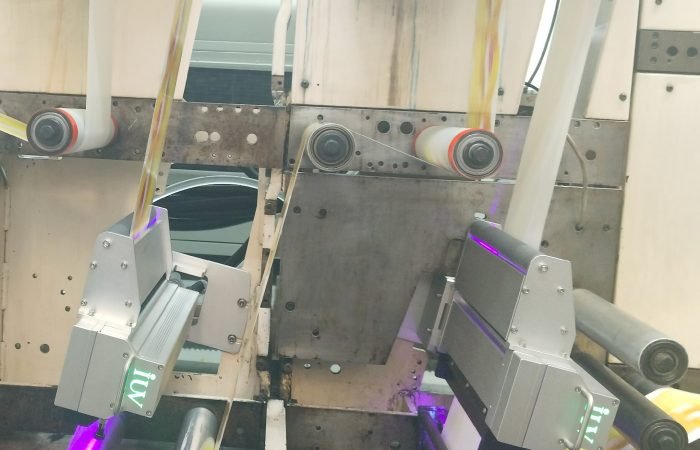When it comes to printing, the right curing system can make all the difference. It impacts everything from print quality to production speed and even your operational costs. Today, we’re focusing on LED UV curing systems, a technology that’s revolutionized many printing processes. We’ll explore how to choose the right one for your specific application, keeping labels, flexography, offset, and narrow-web printing in mind.
Understanding LED UV Curing in Printing
First, let’s clarify what LED UV curing is. Unlike traditional mercury lamps, LED (Light Emitting Diode) systems emit UV light at specific wavelengths. This targeted emission is highly efficient. It means less wasted energy and a more consistent cure. For printing applications, this translates to sharper dots, better ink adhesion, and enhanced durability of the final product. The narrow wavelength output also means less heat generated, which is a significant advantage, especially for heat-sensitive substrates.
Key Factors for Choosing Your LED Curing System
Choosing the right system involves looking at several critical factors. It’s not a one-size-fits-all situation.
1. Application Type: Your primary printing method is the biggest driver.
- Label Printing: Narrow web label printers often benefit immensely from LED curing. The compact size of LED units allows for easy integration into existing presses. The immediate cure on labels means faster handling and finishing. This is crucial for high-volume label production. You’ll want a system that offers precise control over the UV output. This ensures consistent color and adhesion on a wide range of label stocks, from paper to films. Think about the specific inks you’re using. Some inks are formulated for specific LED wavelengths.
- Flexographic Printing: For flexo, especially in narrow web, LED curing offers a significant advantage. The precise control allows for sharper print definition and better ink transfer. This is vital for detailed graphics and fine text often found on labels and packaging. The low heat output from LEDs is also a boon for thin film substrates commonly used in flexible packaging. Ensure the LED system has sufficient power density to cure your chosen inks at your desired press speeds. Uniformity of cure across the web is also paramount here.
- Offset Printing: While offset printing has traditionally used mercury lamps, LED UV curing is making inroads. For sheetfed offset, LED systems can offer faster turnaround times. Jobs can be handled, stacked, and finished immediately without smudging. The lower energy consumption is also attractive. For web offset, especially in niche applications or where faster drying is needed, LEDs can be considered. The consistent, uniform output of LEDs helps maintain color consistency from the first sheet to the last.
2. Substrate Material: What are you printing on? This is a major consideration.
- Paper and Cardboard: These are generally forgiving. However, the absorption of UV light by paper can affect curing efficiency. The right wavelength and intensity are key to ensuring the ink cures properly without damaging the paper fibers.
- Plastics and Films: Many films are non-porous and can be sensitive to heat. This is where LED UV excels. The targeted wavelengths cure the ink quickly without significantly raising the substrate temperature. You’ll need to ensure the LED system is powerful enough to cure through any potential opacity in the film or primer.
- Heat-Sensitive Materials: If your application involves materials that degrade or warp with heat, LED curing is almost certainly your best bet. The minimal heat output compared to arc lamps means you can achieve a durable cure without compromising the substrate.
3. Ink and Coating Chemistry: Not all UV-curable inks and coatings are created equal.
- Wavelength Compatibility: This is non-negotiable. LED systems emit light in specific narrow bands, typically around 365 nm, 385 nm, 395 nm, or 405 nm. Your inks and coatings must be formulated to cure efficiently at these specific wavelengths. Using an ink designed for a mercury lamp with an LED system, or vice-versa, will result in incomplete curing, poor adhesion, and potential print defects. Always check the ink manufacturer’s specifications for compatibility.
- Cure Speed and Depth: Different ink formulations will cure at different speeds. The required intensity (irradiance) and total energy (dose) will vary. High-speed printing requires systems that can deliver a high irradiance to cure the ink in fractions of a second. For thicker ink layers or opaque inks, deeper penetration of UV light is needed, which might require a specific wavelength or higher energy dose.
4. Printing Speed Requirements: How fast do you need to print?
The speed of your printing press directly dictates the required power of the LED curing system. A faster press needs an LED system with higher irradiance (power density, measured in W/cm²). This ensures the ink receives enough UV energy within the very short time it passes under the lamp. If the irradiance is too low for the speed, the ink won’t cure properly. It’s a balancing act between press speed, ink chemistry, and the LED system’s output capabilities.
5. Environmental and Energy Considerations:
LED UV curing systems are significantly more energy-efficient than traditional mercury lamp systems. They consume less power and generate less heat. This can lead to substantial cost savings on energy bills. They also have a longer lifespan, reducing maintenance and replacement costs. The lack of ozone production is another environmental benefit. Furthermore, the reduced heat can lower the demand on your HVAC system.
6. Integration and Space:
Consider the physical dimensions of the LED curing system. Can it be easily retrofitted onto your existing printing press? Many LED systems are modular and designed for straightforward integration. Ensure there’s adequate space for the curing unit itself and any associated power supplies or control modules. For narrow web presses, compact designs are often essential.
Specifics for Different Printing Processes
- Narrow Web Printing (Labels












